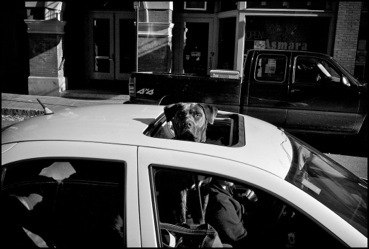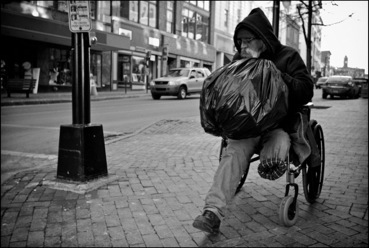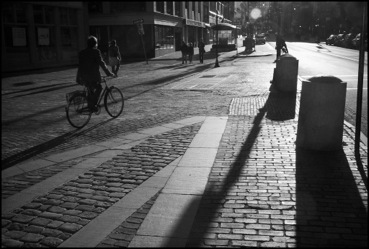Doug Bruns moved to Portland from Baltimore in 2009 and proceeded to wander around the city with a 35-mm camera.
His purpose was simply to chronicle his surroundings and send images to his friends and family to introduce them to his new city. He shot a lot of nice images and captured Portland with an artistic flair. For a while, he posted his photos on Facebook for all to see.
In short order, he tired of that postcard-home approach.
“I became a lot more interested in the dynamics of the street life of Portland, which is really interesting,” said Bruns, who is retired and lives in the Old Port.
He spent more than a year taking black-and-white photos of Portland. He was interested not in pretty pictures, but the daily pulse of life on the street. He practiced street photography in the traditional sense. He shot everything that moved: Buskers, lovers, vendors, workers, walkers, joggers, preachers, patriots, cops and dock workers.
When he was satisfied that he captured all that he wanted, Bruns took a break. He began his project with the goal of documenting his new city, and it took him more than a year to do so. Task completed, he put his work aside and moved on to other things.
He did not intend to show his work to anyone other than his friends. He wasn’t interested in a gallery exhibition or selling prints. The idea of a book barely crossed his mind.
He was solely interested in satisfying a profound urge toward creativity.
When Bruns revisited his work several months ago, he was struck by the notion that he should do something with it.
“I spent quite a bit of time working on it, then I put it away. It sat for at least a year after I finished taking the pictures. Then I decided to take another look at it, and when I did, I liked it,” he said over a beer or two at LFK at Longfellow Square.
So what to do with it?
Bruns decided to make a book – a single book. He self-published one copy of “Portland at Street Level” and passed it around to friends to measure their reaction and interest. Of course people said they liked it, and they were telling the truth.
“Portland at Street Level” pulls together about 100 of Bruns best photographs, mostly gritty black-and-white images of a vibrant city. His work took him to all quarters of the peninsula, but mostly he concentrated on the spine of Congress Street from Munjoy Hill to the West End. “Now that’s a street that has a lot of character,” he said.
Interest renewed, he’s debating what to do with his book.
Should be print more copies and try to sell it? Should he do a small run and distribute the book simply for viewing pleasure to local coffee shops, watering holes and reading rooms?
He understands the market for a book such as this is limited. It’s not a pretty-picture book that appeals to visitors. Locals might care, but enough to buy? It’s not a journalistic effort that documents a specific element of Portland.
It is one man’s view of a city that he has come to dearly and deeply love, and one that he has come to know intimately. Indeed, Bruns knows the nuance, character and tenor of the peninsula better than many people who have lived and worked here for a much longer period of time.
He goes everywhere on foot.
When you walk where you go, you interact with people and things you would not otherwise. You see things that you would miss in a car. You talk to people you encounter. You look them in the eye and get to know them, even if you do not know their names. There is a sense of familiarity.
“I consider the peninsula my home. When I cross under the trestle, I feel I’m not in my hometown. There is something about the brick buildings and the character of the people that appeal to my sensibilities,” he said.
“I get the sense that Portland is not aspiring to be Portland, Ore., or Austin. Portland is very much trying to be itself. It has a high degree of authenticity about it.”
That is what “Portland at Street Level” is all about. It’s an authentic view of a very special place, and that is its value.
“Portland is a black-and-white city. Period,” Bruns said.
“It is gritty, not gritty like I think Pittsburgh or Detroit is gritty, but gritty in some old-world, bracing-the-elements, hard-scrapple-way gritty. Gritty is the stuff of black and white. I never considered the project as a color project. Portland for me is a city of monochrome.”
Staff Writer Bob Keyes can be contacted at 791-6457 or:
bkeyes@pressherald.com
Twitter: pphbkeyes
Send questions/comments to the editors.





Success. Please wait for the page to reload. If the page does not reload within 5 seconds, please refresh the page.
Enter your email and password to access comments.
Hi, to comment on stories you must . This profile is in addition to your subscription and website login.
Already have a commenting profile? .
Invalid username/password.
Please check your email to confirm and complete your registration.
Only subscribers are eligible to post comments. Please subscribe or login first for digital access. Here’s why.
Use the form below to reset your password. When you've submitted your account email, we will send an email with a reset code.